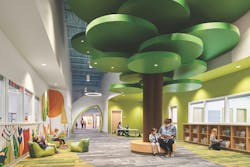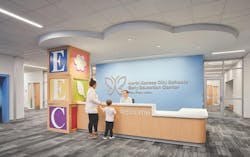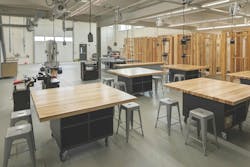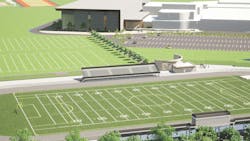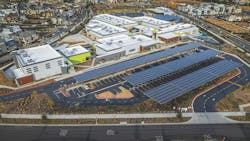K-12 school sector trends for 2023
C.W. Driver recently began construction on a 75,000-sf elementary school for the Menifee Union School District in California. The 23-classroom building, whose completion is scheduled for July 2024, will cost $54.5 million; that’s about $20 million more than it might have cost four years ago, estimates Andy Feth, PE, DBIA, LEED AP, C.W. Driver’s Project Executive in San Diego, whom BD+C interviewed with Tom Jones, a Project Director in Pasadena.
Feth frets that some projects scheduled to start at the tail end of this school district’s current bond funding “aren’t going to happen,” at least in that round.
One of the biggest factors weighing on K-12 school construction these days is “the escalation of everything,” says Tracy Richter, Vice President of Planning Services for Alabama-based project management firm HPM. In some cases, planning dollars are “far less” than the project’s final cost, and estimating can sometimes be daunting. Richter points specifically to one school project in Idaho that, before land costs, ran $500 per sf, or about $200 per sf more than a comparable project would have priced out five years earlier.
Because of this uncertainty, Richter says projects are attracting fewer bidders, and that lack of competition keeps prices higher, too.
Jason Morgan, Executive Vice President and Principal with the Florida-based GC Charles Perry Partners, says that in the past, it would have been “unheard of” ordering chillers or air handlers in advance of final documents. But now, with school districts spending cautiously, supply-chain snags, and inflation still swinging upward, his firm strives to get equipment on-site as early as possible. “Budgeting is always a concern. We have to keep getting smarter, and be honest upfront” about what projects will cost, he says.
Over the past year, Minnesota-based Wold Architects & Engineers has seen the pricing of materials stabilize for its K-12 school projects. “But there have been some rebid scenarios,” concedes Vaughn Dierks, a Partner with the firm. He adds that labor shortages remain “the number one issue” and have led to inconsistencies in critical path scheduling. Wold’s solution to keep projects on schedule and budget, he says, has been more frequent meetings with owners and contractors.
“School districts have been getting caught off guard by the cost of construction,” which can be as much as two-thirds higher than planned for, observes Bill Bradley, Principal and Practice Leader for Stantec. The good news, he says, is that clients and governing agencies “recognize that things cost more” and are finding the money to complete school projects without making draconian design changes.
Healthy demand for K-12 school building projects
AEC firms report that, for the most part, their K-12 business is brisk and bond financing for public schools remains healthy. Last September, for example, the New Jersey School Development Authority (SDA) approved an additional 16 school construction projects to the state’s 2022 Capital Plan, made possible by funding appropriated in the fiscal year 2023 budget that includes $1.55 billion to advance a dozen school construction projects in SDA districts, and $350 million for facilities projects in regular operating districts.
“We do a lot of K-12 work in Chicago, which accounts for 30% [of the firm’s sector business] this year, and demand has been surprisingly strong,” says Stan Pepper, Chairman and CEO of Pepper Construction, which has five school projects in the works.
The GC Barton Malow’s K-12 backlog is bigger than at any time in its history, says Jeff Atkins, Project Executive for the firm’s K-12 group. “And we’re seeing record-sized projects, up to $500 million. I used to think that $10 million was a big project.” Mike Stobak, a Vice President in the K-12 group, cautions that, with labor shortages, “we have to be careful about what we promise.” He and Atkins concur that school districts, in a concession to market realities, are more receptive to allowing construction during the school year, and not just during summer months.
Also shifting are school district priorities. Todd Ferking, AIA, Principal and National K-12 Education Design Leader for DLR Group, says that more of his firm’s clients are refocusing on equity, based on the needs of their communities. This can include using schools as family resource centers, and forming partnerships with local housing authorities. Ferking points specifically to the Austin (Texas) Independent School District, that follows an Equity Action Plan. In the Hilltop neighborhood in Tacoma, Wash., McCarver Elementary School has been offering a housing assistance program that promotes family stability.
From DLR Group’s standpoint, “a lot of what we do is listening,” says Ferking, to provide communities with a full account of what school design can and can’t accomplish.
Must-have spaces in K-12 school buildings
Stantec’s Bradley laments that school leaders are under “more pressure than ever” from dealing with issues that often are more related to politics than education. “School boards have to be careful what they say” for fear of being misinterpreted. Consequently, school leaders can be reluctant to “lean in and take chances” on school design and construction beyond addressing capacity needs. That reluctance, says Bradley, can result in “missed opportunities” if school facilities don’t evolve.
He views Stantec as “the trim tab on the rudder of a big ship,” having gradual impacts on school districts’ planning. One significant success, dating back to 2015, was the Frederick County Middle School in Winchester, Va., which Stantec designed around student-directed learning, a concept that has since caught on in school districts across the country.
RELATED
2022 K-12 School Sector Giants Rankings
• Top 160 K-12 School Sector Architecture and AE Firms
• Top 70 K-12 School Sector Engineering and EA Firms
• Top 100 K-12 School Sector Contractors and CM Firms
The K-12 school system in the U.S., though, is so decentralized that it’s harder to pinpoint design or construction trends beyond such standard demands for flexible, collaborative spaces and tighter security around the perimeter and inside schools. Post-pandemic, school districts have placed greater emphasis on hygiene, health, and safety, observes Misty DuPre, Principal with the engineering firm Salas O’Brien in southern California.
AEC firms also cite fieldhouses and space for robotics competitions among the recent “must-have” requests from their clients.
Top trends in K-12 school design and construction for 2023
Nevertheless, based on conversations with a dozen AEC firms, some trends do emerge that are affecting school curriculums and how facilities are configured, designed, and operated:
Career and technology education (CTE)
School districts are aware that not every kid is headed for college. Wold’s Dierks and other AEC sources are seeing districts leaning toward training and education for a wider range of post-secondary options. Chris Greer, PE, LEED AP, Henderson Engineers’ Community Sector K-12 Education Practice Director, cites The Barstow School’s Dan and Cassidy Towriss IDEA Space KC in Leawood, Kan., a former grocery store converted to a 60,000-sf STEAM incubation hub that opened last September to serve students from kindergarten to grade 12. Its programming focuses on skilled trades, engineering, advanced manufacturing, and computer science.
“There’s much discussion around CTE and ‘pathways’ for students,” says Jay Ripsky, Executive Vice President and Operations Manager at Pepper Construction’s Barrington, Ill., office. He notes that as schools add skilled trades programs, more infrastructure in the buildings is required. Ripsky also says that some schools are designing workshop and training areas so that other students can watch what’s going on inside.
Stobak of Barton Malow has been seeing vocational programs in schools that are geared specifically toward CNC, HVAC, and other mechanical expertise. His firm recently completed a school whose skilled trades program includes front loaders and other construction equipment for student use.
Bradley of Stantec goes so far as to state that CTE is becoming “integral” to K-12 learning. He cites as one model the Academies of Loudon, a high school in Leesburg, Va., that houses separate centers for math, science, and CTE. Since this school opened in 2016, it has hosted visitors from around the world interested in its design and operations, says Bradley.
DLR Group designed the 117,000-sf Cherry Creek Innovation Campus, which opened in Centennial, Colo., in August 2022 and presents career and technical opportunities to 11th and 12th graders. The school district partnered with the Colorado Workforce Development Council to identify career paths for students’ training at the Innovation Campus.
Aside from CTE, schools are also devoting classroom space for specialized learning that runs the gamut from aviation and agriculture, business and medical services, to culinary and fine arts, the latter of which several AEC sources report has been making a comeback in curriculums.
Fine arts additions were part of the referendum plan for the upgrading of two high schools serving Hinsdale and Darien, Ill. In fact, that referendum passed on its third try, after the district chose to focus on academic and extracurricular programs that would keep the high schools competitive with surrounding schools. Designed by ARCON and built by Pepper Construction, this $140 million project, which will be completed in September, upgrades the schools’ cafeteria and libraries, technology capabilities, and athletic facilities.
School consolidation
During the school year 2022, there were 1.3 million fewer students in all grades of public schools than the 51 million enrolled in school year 2020, according to an analysis by EY-Parthenon of data from sources that include the National Center for Education Statistics and the Census Bureau. Birth rate declines appear to account for about 25% of the preK-12 enrollment drop. And absent changes to the nation’s currently restrictive immigration policy, net enrollment is likely to continue its descent through at least 2037.
School enrollment is a function of a market’s economic and population growth. Richter of HPM notes that the state of Ohio last year had 3,500 fewer births than in 2021, and that Hilliard, Ohio, had a net gain of only 350 children from 2010 through 2022, even as that town’s total population rose to 39,000 from 28,000 during those 12 years. On the other hand, says Pepper Construction’s Ripsky, the dynamics are different in New Albany, Ohio, near Columbus, where Intel is committed to spending $20 billion on chip manufacturing plants within a 1,000-acre campus, an investment that is creating thousands of construction and permanent jobs, and is likely to drive future decisions about school needs and curricula.
“None of us is immune to this EKG world,” quips Richter. And when districts shrink, school consolidation often follows, which presents renovation and addition opportunities to AEC firms.
But one thing’s for certain: districts are battling to hold onto students for as many grades as possible. Richter notes that in Indiana, 30-40% of students leave elementary school districts by choice. So districts have been tweaking their boundaries to ensure predictable feeder patterns.
This battle, for many districts, starts at the Pre-K level, and AEC firms say they’ve seen demand for these schools spike. “This has been huge for us,” says Atkins of Barton Malow, which had just completed a 70,000-sf preschool. (It’s noteworthy, too, that Michigan’s Gov. Gretchen Whitmer has been pitching free Pre-K education for four-year-olds.)
In early April, the GC Gilbane Building Company topped off the 191,028-sf, three-story West Elementary School on 34 acres in Andover, Mass. When it’s completed next year, this K-5 school will include a separate, dedicated two-story wing for 130 PreK students that will be the new home for the town’s Shawsheen Preschool. West Elementary and Shawsheen were designed by SMMA, with PMA Consultants acting as the owner’s rep.
Jim LaPosta, Principal and Chief Architectural Officer for New York-based JCJ Architecture, foresees early learning centers as a wave of the future for the K-12 sector. He points, by way of example, to the 54,340-sf Dr. Sarah Jandrucko Academy for Early Learners in Arlington, Texas, designed by Huckabee and opened in January 2019, which functions like a museum to provide its 400 three- and four-year-olds with interactive and unique learning experiences.
Build new, make do, or adapt
The value of educational construction in place stood at $105.3 billion in February, 6.9% higher than the same month in 2022, according to U.S. Census Bureau estimates. There are still plenty of new schools being built. But while most AEC firms contacted for this article say demand in this sector is steady, the work they’re doing ranges widely, from new construction and additions to upgrades of existing structures and campuses.
“There are so many 1960s-era schools in Detroit. Do we keep putting money into these, or replace them?” asks Atkins of Barton Marlow.
“In a good economy, there’s more repurposing of space, whereas maintenance is emphasized in a bad economy,” says Pepper Construction’s Ripsky. Right now, about 60% of funding for projects his firm bids on is earmarked for facility maintenance. Renovations and additions make up the bulk of Wold’s K-12 activity lately, says Dierks, who notes, too, his firm has also done some “rightsizing” and replacements with less square footage.
DuPre of Salas O’Brien says that much of her firm’s K-12 work these days is modernization of operational systems. Recently, Salas O’Brien added air conditioning to Peterson Elementary School in Huntington Beach, Calif.; at LaGranada (Calif.) Elementary School, her firm reconfigured spaces, updated the lobby, and made the building more secure. She notes that, because of labor shortages, schools want operating systems that can be run and monitored remotely.
Henderson Engineers is providing MEP/FP/AV and acoustics services for the $145.7 million modernization of the 400,000-sf Taft Charter High School in Woodland Hills, Calif., a 16-building complex on 32.4 acres. The scope of this project—designed by NAC Architecture and built by Kemp Brothers Construction—includes new buildings, seismic retrofits, and renovations. The work should be completed by spring of 2026.
School districts also seem more open to considering adaptive reuse as part of their asset improvement programs. DLR Group recently converted a shopping mall in Missouri into an early learning center, and added a middle school to an office building in the Pacific Northwest, says Ferking.
Henderson Engineers provided services for the conversion of a 41,000-sf former Orschein Farm and Home store in Peculiar, Mo., to the Ray Pec LEAD Center, which opened last September and includes programs for computer-integrated machining, Enterprise and Design, electrical studies, HVAC, carpentry, plumbing, automation, and robotics.
Schools preach safety first
Last February, C.W. Driver completed construction on the $52.5 million Solis Park School for the Irvine (Calif.) Unified School District. This 106,000-sf K-8 school was designed by PJHM Architects to meet criteria developed by the Collaborative of High-Performance Schools that emphasizes the connection between learning, healthier spaces, and energy efficiency.
The coronavirus pandemic and the remote learning it engendered raised awareness about the roles that schools play in the social and emotional wellbeing of students, teachers, and staff. Districts are looking for design solutions that help create “cultures of collaboration” and social interaction via huddle rooms, furniture options, and greater agency over their surroundings, says Emily Czarnecki, Associate Principal and Lead Interior Designer for JCJ Architecture.
“It’s about making kids feel more comfortable, with quiet and safe spaces, where they can work together in small groups,” she explains. “That can be life changing.” Wold’s Dierks adds that the mental health of students and staff has become one of the top concerns of clients. The goal of recent projects has included creating a “calmer environment,” he says, through acoustics, lighting, furniture, and what he calls “de-escalation spaces.”
Czarnecki and other AEC sources spoke about the increasing demand for outdoor learning spaces that not only expose students to fresh air but allow for teaching everything from gardening to science “in a structured way,” says JCJ’s LaPosta.
Some schools are tying their social agendas to sustainability. Ferking of DLR Group says Seattle Public Schools’ replacement for its PreK-5 John Rogers Elementary School, whose construction starts this summer, is designed to be net zero energy when it opens in the fall of 2025. Greer of Henderson Engineers says that some of his firm’s clients that are looking into net-zero projects want to use that objective as a teaching tool for students.

